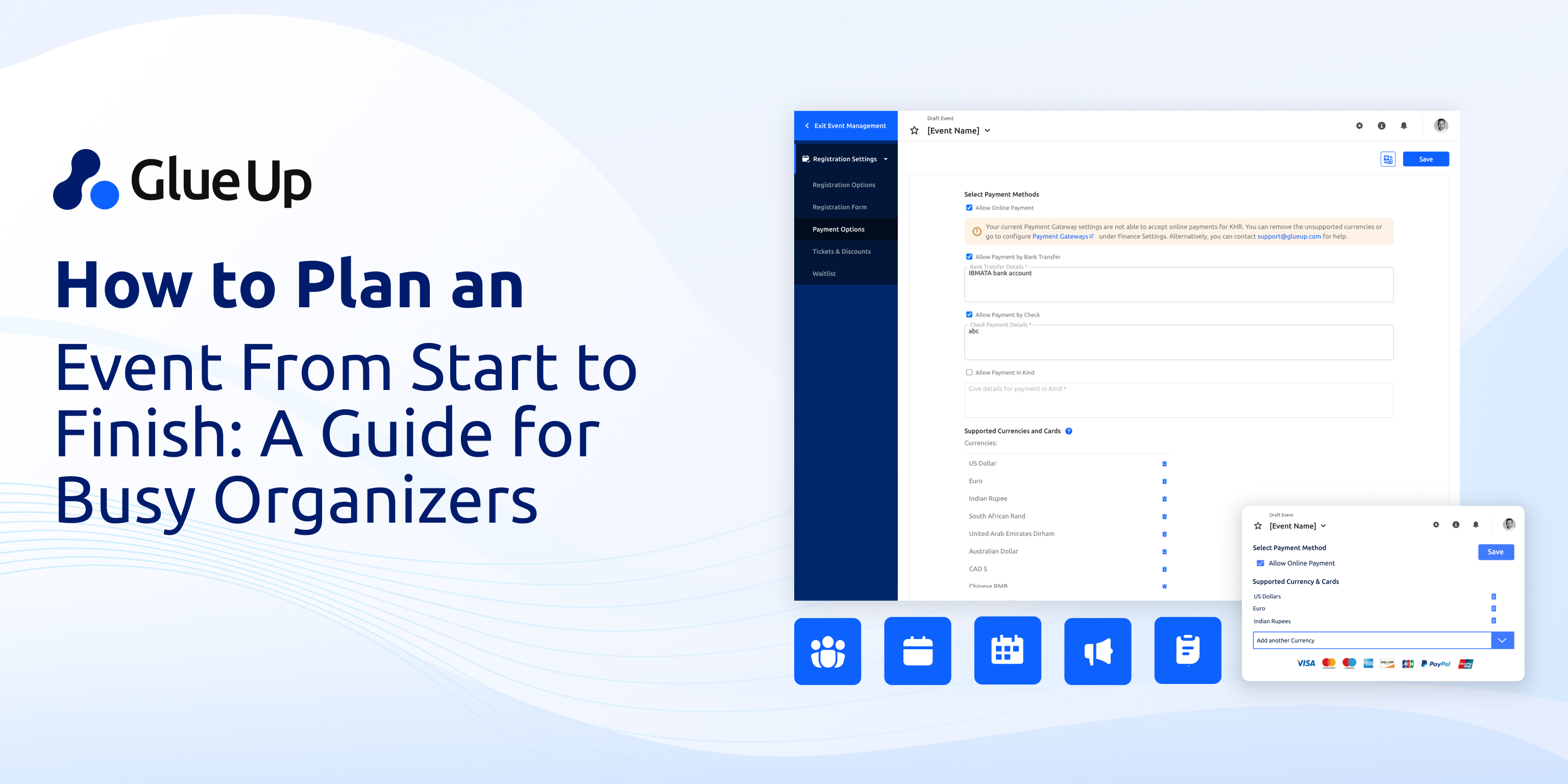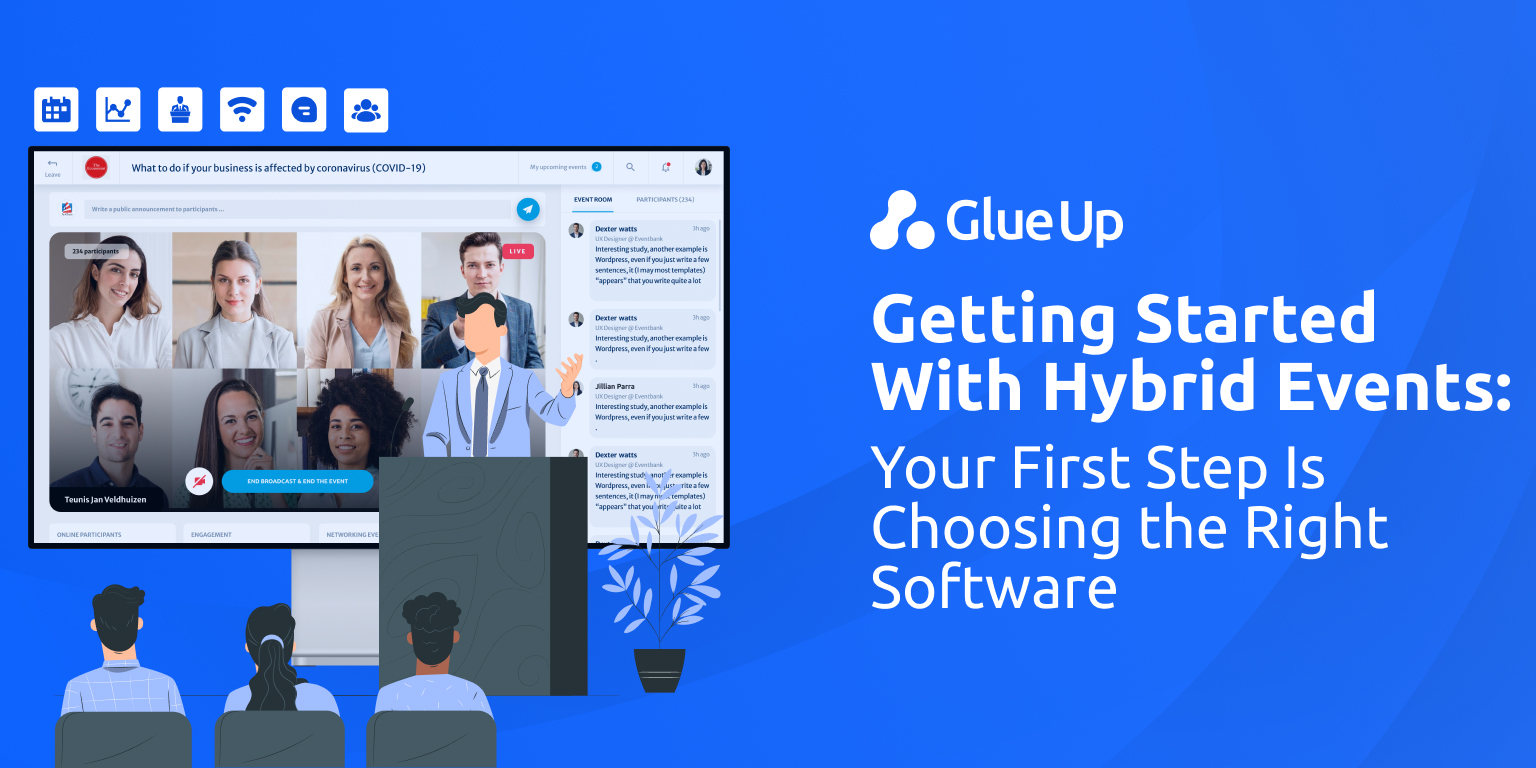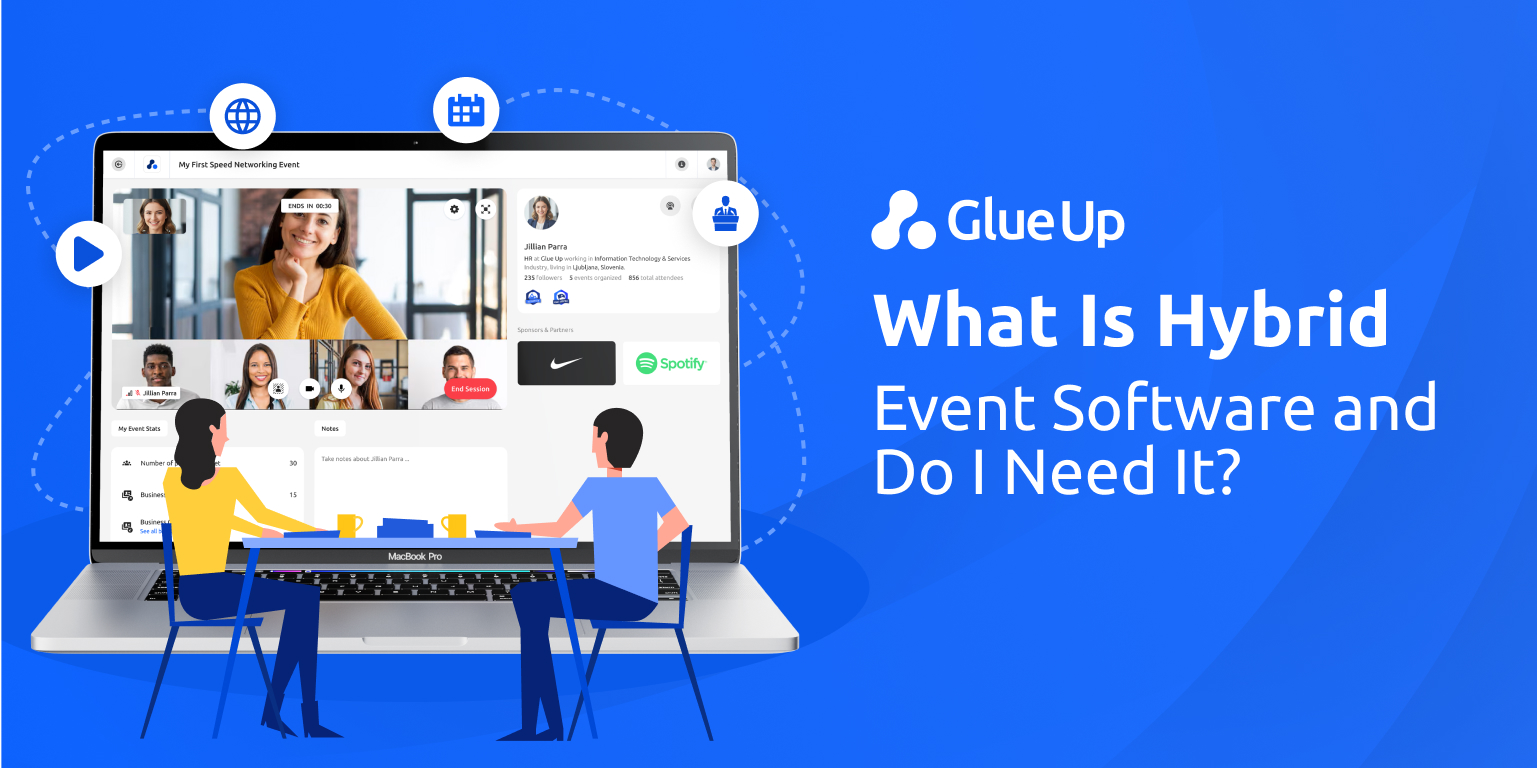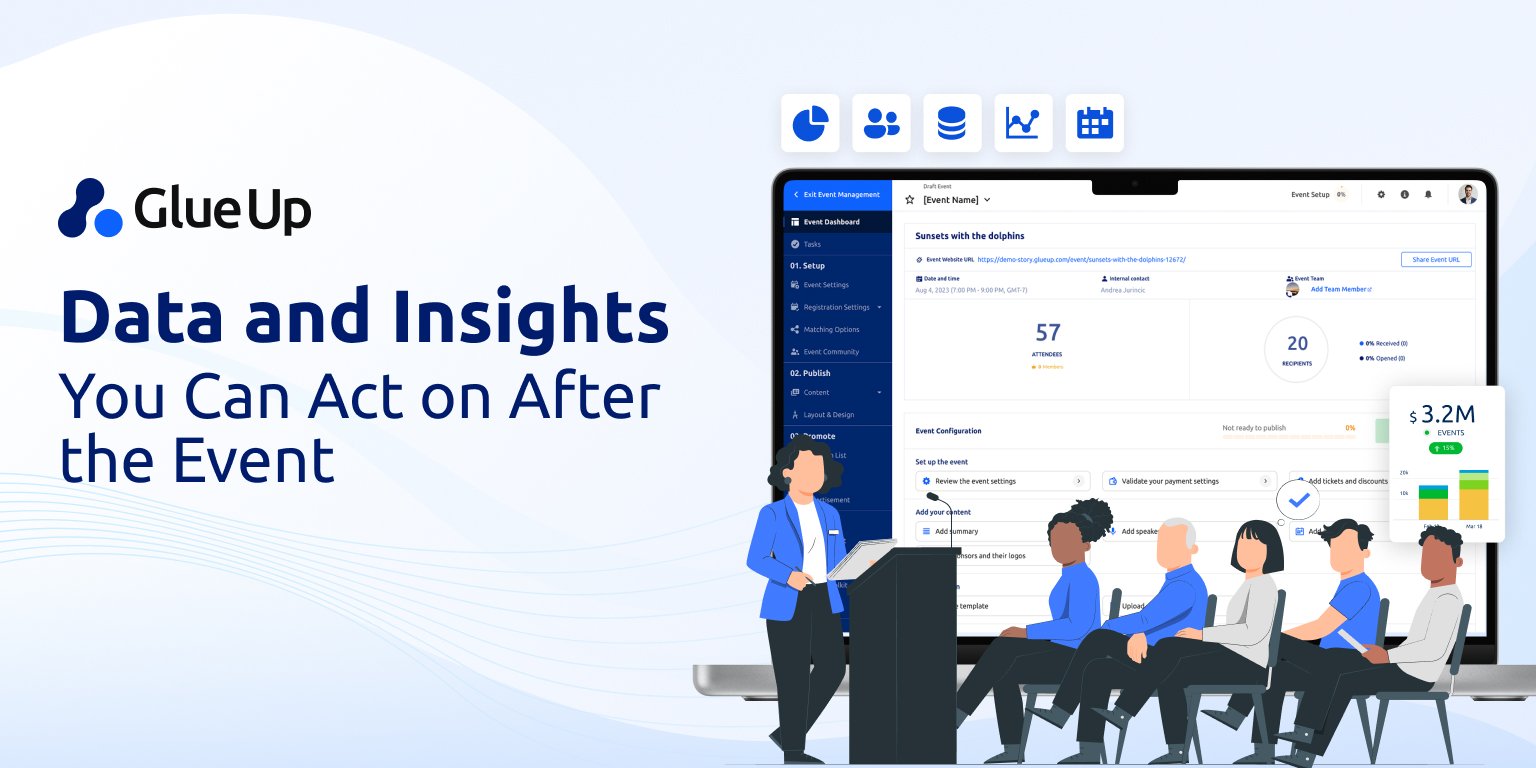
Planning an event can feel like juggling a dozen tasks at once, especially when you’ve got limited time and a packed schedule. Whether you’re organizing a workshop, networking mixer, or annual conference, the key to success is having a clear process that keeps things moving without burning you out.
This guide is built for organizers who want to run efficient, engaging events without the stress. From setting goals to post-event follow-up, we’ll walk through every step in plain language, giving you tips and tools you can actually use. Ready to get organized? Let’s go step by step.
Key Takeaways
- Defining your event goals early on makes every decision easier, from format, promotion, budgeting, and even follow-up.
- Don’t pick virtual, hybrid, or in-person just because it’s trendy. Align the format with your audience, goals, and resources.
- Busy organizers need automation, mobile access, and integrated tools to save time and reduce errors. All-in-one platforms like Glue Up simplify every stage.
- A consistent, multichannel promotion plan, including email, social, and partnerships, is key to filling seats and building excitement.
- Follow-ups, feedback, and post-event insights turn a one-time gathering into long-term value for your organization and your attendees.
Quick Reads
- AI-Powered CRM in Membership Management
- Partnership vs Sponsorship: What’s Best for You?
- How AI is Revolutionizing Event Planning
- Comparing the Best Association Management Software
- Transform Your Financial Management with Tools
- How to Promote Membership in the Most Effective Ways
Set Clear Goals From the Beginning
Every successful event starts with a purpose. Before you choose a venue or send your first email, ask yourself: Why are we hosting this event? The answer should guide every decision moving forward.
Are you:
- Trying to attract new members?
- Providing value to current members?
- Launching a new initiative or product?
- Raising funds or awareness?
Clear goals will help you determine the right format, audience, budget, and even the follow-up plan.
Bonus: They will also help your team stay aligned and measure success once the event wraps up.
Choose the Right Event Format
Once your goals are clear, pick the format that best supports them. The structure of your event plays a big role in how engaged your attendees will be.
Consider:
- In-person events for hands-on experiences or local networking
- Virtual events for convenience, broader reach, and lower costs, as per stats, 63% of event organizers plan to invest more in virtual events in 2025
- Hybrid events to blend both audiences and extend flexibility, with 74.5% of planners adopting hybrid formats, make it a favorable choice for event planners
Also, think about the structure: panels, workshops, speed networking, and roundtables, each of which serves a different purpose. Align the format with the outcome you’re aiming for.
Set a Realistic Budget and Stick to It
Your budget is the foundation of your event plan. It guides everything from venue choice to marketing strategy. Start by listing your essential expenses:
- Venue or platform fees
- Catering or virtual event tools
- Speaker or entertainment costs
- Marketing and promotion
- Tech support or staffing
- Swag, gifts, or follow-up materials
Then, add a buffer, usually 10–15%, for unexpected costs. Keep tracking actual expenses against your plan to avoid overspending. A clear budget ensures smart decisions and fewer surprises.
Create a Detailed Planning Timeline
A well-structured timeline turns a chaotic event into a smooth experience. Break down your event into phases:
8–12 Weeks Out:
- Set your goals
- Book a venue or a virtual platform
- Confirm date and speakers
6–8 Weeks Out:
- Open registration
- Start promoting
- Finalize sponsors or partners
2–4 Weeks Out:
- Send reminders
- Confirm tech setups and logistics
- Prep materials or attendee kits
1 Week Out:
- Final checklist
- Team briefing
- Dry run or tech rehearsal
Stick to your timeline like a roadmap because it is. Every task should have an owner and a deadline.
Choose the Right Event Technology
The right tools can make or break your event, especially when you’re short on time or juggling multiple tasks.
Here’s what to look for:
- All-in-one platforms: Tools like Glue Up let you manage registration, promotions, reminders, payments, and post-event analytics from one place.
- Custom registration forms: Make it easy for attendees to sign up, pay, and get reminders.
- Mobile access: You need tools that work on the go, for you and your attendees.
- Built-in engagement tools: Look for features like live chat, digital business cards, feedback forms, and automated follow-ups.
Choosing tech that works for you means less manual work and more time to focus on delivering a great experience.
Delegate Roles and Responsibilities
Even if you’re the main organizer, you don’t have to do it all alone. Clearly assigning roles can reduce confusion and increase accountability.
Here are a few roles to consider:
- Event lead: Oversees the full plan and timeline.
- Communications lead: Handles email updates, social media, and attendee messaging.
- Logistics coordinator: Manages venue setup, tech requirements, and supplies.
- Speaker or guest liaison: Keeps presenters informed and supported.
- Check-in team: Welcomes attendees and manages registration on the day of the event.
Whether you're working with a team of five or relying on volunteers, make sure everyone knows what they’re responsible for.
Promote Your Event Effectively
No matter how well you plan, your event will not succeed without attendees. That’s why smart, targeted promotion is crucial.
Here’s how to get the word out:
- Email campaigns: Send personalized invitations and reminders to your contact list. Include clear value statements and CTAs.
- Social media posts: Share updates across your platforms. Use graphics, countdowns, or short video clips to grab attention.
- Event listings: Post your event on relevant calendars, directories, and partner websites.
- Leverage your network: Ask speakers, sponsors, and partners to help promote through their own channels.
- Exclusive offers: Early bird pricing or limited-access spots can create urgency.
Don’t rely on a single email or post; plan a promotional calendar that builds excitement over time.
Prepare for Smooth Check-in and On-Site Logistics
Event day should feel organized, not chaotic, for both your team and your attendees.
Here’s what to lock in before the doors open:
- Registration lists and badges: Print them early or set up digital check-in via QR codes.
- Signage and layout: Make it easy for guests to find the registration desk, session rooms, and restrooms.
- Staff assignments: Everyone on your team should know their role, greeters, troubleshooters, tech support, etc.
- Backup plans: Have extra chargers, extension cords, a first-aid kit, and a plan for no-shows or delays.
- Tech check: Test microphones, projectors, and internet at least a day before (or run a dry run if virtual).
A calm, confident setup sets the tone for a great experience.
Engage Your Attendees During the Event
Planning is only half the battle. How your attendees feel during the event determines whether they’ll return.
Here’s how to keep the energy and interaction high:
- Use live polls or Q&A tools to invite participation during sessions.
- Encourage networking with built-in breaks, lounges, or a dedicated app for 1-on-1 chats.
- Gamify the experience, add a points system, a scavenger hunt, or a reward for the most connections made.
- Have visible staff or volunteers helping attendees with questions or directions.
- Share live updates on social media and encourage your audience to post with event hashtags.
If you're using Glue Up, you can push updates, chat directly, or scan tickets right from the Manager App and Member App.
Follow Up and Measure Success
The event might be over, but your work isn’t. What you do after the event can make or break your long-term impact.
Here’s what to focus on:
- Send a thank-you email within 24 hours. Include presentation slides, key takeaways, or recorded sessions.
- Ask for feedback with a short survey on what worked, what didn’t, and what they want next time.
- Share highlights via social media or email: photos, top quotes, stats, and outcomes.
- Track KPIs like attendance rate, engagement levels, session popularity, or revenue vs. cost.
- Follow up personally with VIPs, sponsors, or no-shows to maintain the relationship.
If you’re using Glue Up, most of this can be automated reminders, feedback forms, even follow-up tasks inside the CRM tied to individual contact profiles.



